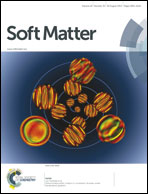Two coupled effects of sub micron silica particles on the mechanical relaxation behavior of ethylene–propylene–diene rubber chains
Abstract
This article studied the influence of silica (SiO2) particles on the crosslinked network and the molecular mobility of ethylene–propylene–diene (EPDM) rubber chains by dynamic mechanical analysis (DMA). When SiO2 fraction is lower than 8 phr, the chain segments that participate in the glass–rubber transition (α transition) decrease with increasing the SiO2 content, while the whole crosslinked network is almost unaffected by the presence of SiO2. When the SiO2 fraction increases to about 20 phr, there appears a new tan δ peak (α′ transition) above the α transition. This could be because the crosslinking reaction took place only on a small scale and the formed network became gradually incomplete when the content of the particles exceeded some critical value, and the α′ transition is attributed primarily to the motion of non-elastic network chains loosely attached to the three-dimensional network. However, at SiO2 loadings higher than 40 phr, the crosslinking density was kept basically constant. The α′ transition is hindered by a restriction of the chain mobility due to SiO2. The different changes of α′ transition depended on the two coupled effects of SiO2, including restricting the chain mobility and decreasing the crosslinking density. Correspondingly, with increasing the mobility of EPDM chains and SiO2-induced strengthening, the mechanical properties of EPDM composite are dramatically improved. With the addition of 20 phr of SiO2 in the EPDM, a 113% increase in the elongation at break, a 510% increase in the fracture energy, and a 283% increase in the tensile strength are achieved.


 Please wait while we load your content...
Please wait while we load your content...